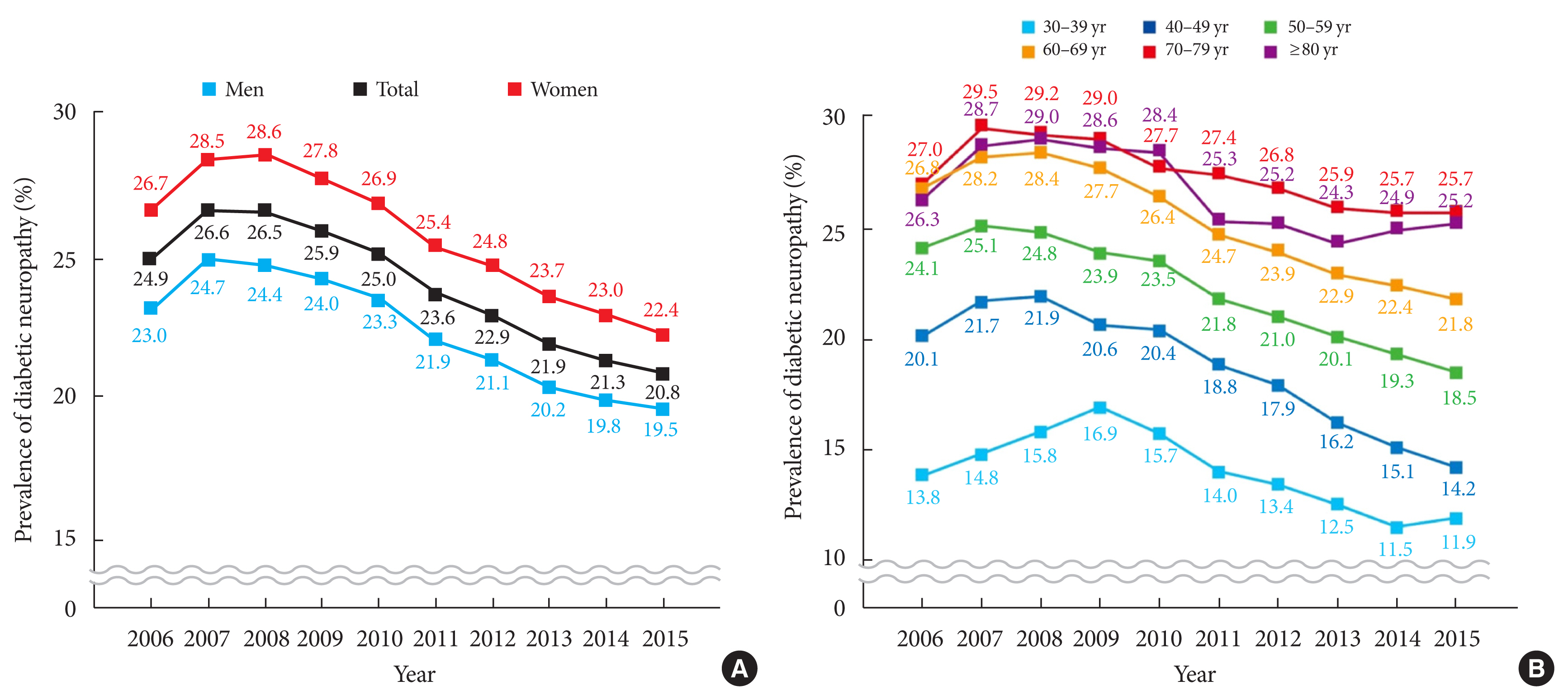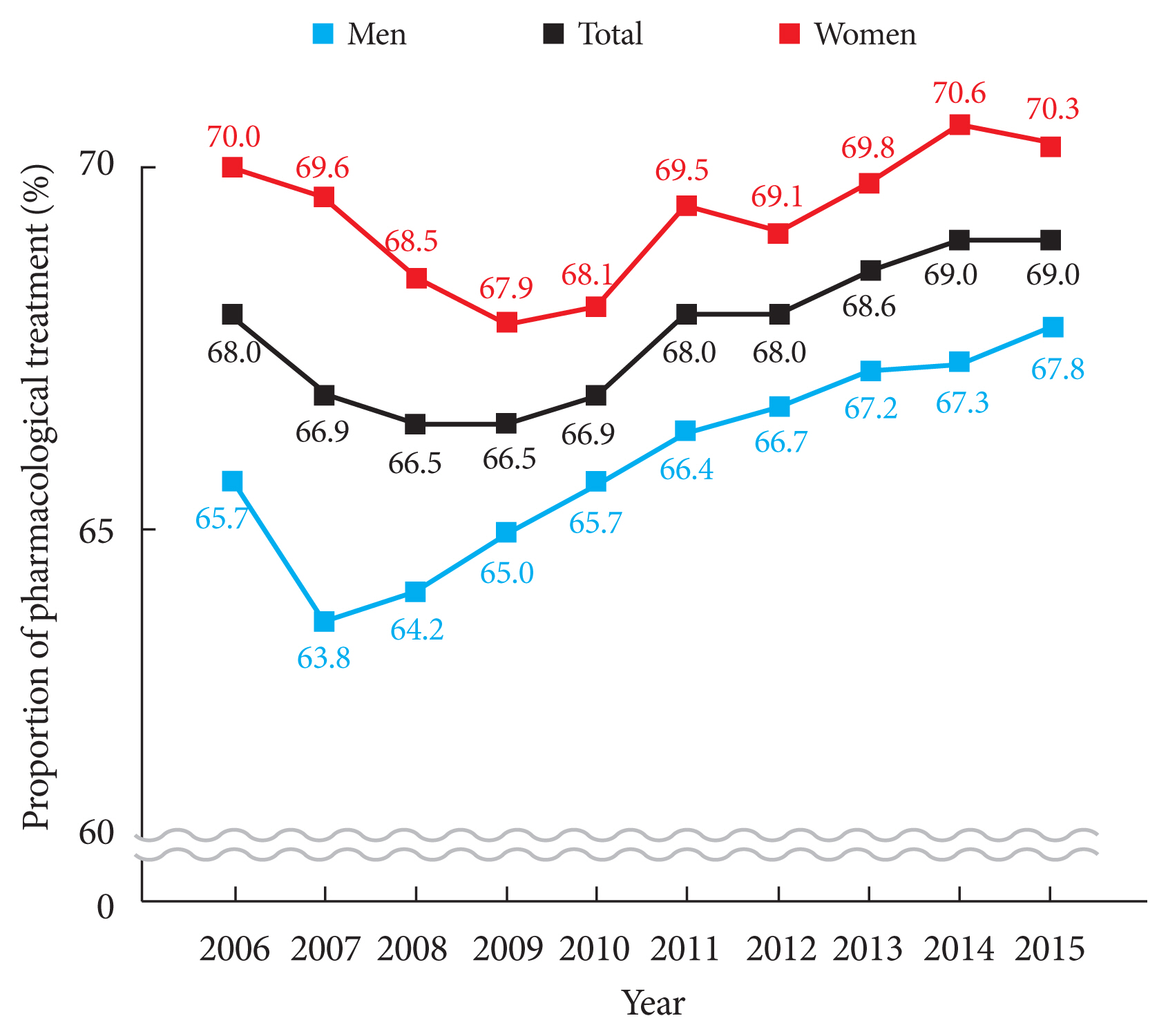Status of Diabetic Neuropathy in Korea: A National Health Insurance Service-National Sample Cohort Analysis (2006 to 2015)
- Affiliations
-
- 1Department of Internal Medicine, Dongguk University College of Medicine, Gyeongju, Korea
- 2Division of Endocrinology and Metabolism, Department of Internal Medicine, Sejong General Hospital, Bucheon, Korea
- 3Department of Internal Medicine, Inje University Busan Paik Hospital, Inje University College of Medicine, Busan, Korea
- 4Department of Internal Medicine, Incheon St. Mary’s Hospital, College of Medicine, The Catholic University of Korea, Incheon, Korea
- 5Department of Internal Medicine, Seoul National University Bundang Hospital, Seoul National University College of Medicine, Seongnam, Korea
- 6Division of Endocrinology and Metabolism, Department of Internal Medicine, St. Vincent’s Hospital, College of Medicine, The Catholic University of Korea, Suwon, Korea
- 7Department of Internal Medicine, Keimyung University School of Medicine, Daegu, Korea
- 8Department of Endocrinology and Metabolism, Ajou University School of Medicine, Suwon, Korea
- 9Division of Endocrinology and Metabolism, Department of Internal Medicine, Jeonbuk National University Medical School, Jeonju, Korea
- KMID: 2514080
- DOI: http://doi.org/10.4093/dmj.2020.0120
Abstract
- This report presents the status of diabetic neuropathy (DN) in Korea as determined using a National Health Insurance ServiceNational Sample Cohort (NHIS-NSC). Annual prevalences of DN were estimated by age and gender using descriptive statistics. Pharmacological treatments for DN were also analyzed. The annual prevalence of DN increased from 24.9% in 2006 to 26.6% in 2007, and thereafter, gradually subsided to 20.8% in 2015. In most cases, pharmacological treatments involved a single drug, which accounted for 91.6% of total prescriptions in 2015. The most commonly used drugs (in decreasing order) were thioctic acid, an anti-convulsive agent, or a tricyclic antidepressant. In conclusion, the prevalence of DN decreased over the 10-year study period. Thioctic acid monotherapy was usually prescribed for DN. To reduce the socio-economic burden of DN, more attention should be paid to the diagnosis of this condition and to the appropriate management of patients.
Figure
Cited by 7 articles
-
Status of Diabetic Neuropathy in Korea: A National Health Insurance Service-National Sample Cohort Analysis (2006 to 2015) (
Diabetes Metab J 2021;45:115-9)
Seong-Su Moon, Chong Hwa Kim, Seon Mee Kang, Eun Sook Kim, Tae Jung Oh, Jae-Seung Yun, Ho Chan Cho, Dae Jung Kim, Tae Sun Park
Diabetes Metab J. 2021;45(3):459-460. doi: 10.4093/dmj.2021.0084.Status of Diabetic Neuropathy in Korea: A National Health Insurance Service-National Sample Cohort Analysis (2006 to 2015) (
Diabetes Metab J 2021;45:115-9)
Tímea Csákvári, Diána Elmer, Lilla Horváth, Imre Boncz
Diabetes Metab J. 2021;45(3):454-456. doi: 10.4093/dmj.2021.0068.Time to Reach Target Glycosylated Hemoglobin Is Associated with Long-Term Durable Glycemic Control and Risk of Diabetic Complications in Patients with Newly Diagnosed Type 2 Diabetes Mellitus: A 6-Year Observational Study (
Diabetes Metab J 2021;45:368-78)
Ja Young Jeon
Diabetes Metab J. 2021;45(4):613-614. doi: 10.4093/dmj.2021.0129.Pathogenesis and Treatment of Diabetic Peripheral Neuropathy
Seon Mee Kang
J Korean Diabetes. 2022;23(4):222-229. doi: 10.4093/jkd.2022.23.4.222.Pharmacological and Nonpharmacological Treatments for Painful Diabetic Peripheral Neuropathy
Han Na Jang, Tae Jung Oh
Diabetes Metab J. 2023;47(6):743-756. doi: 10.4093/dmj.2023.0018.Korean National Burden of Disease: The Importance of Diabetes Management
Chung-Nyun Kim, Yoon-Sun Jung, Young-Eun Kim, Minsu Ock, Seok-Jun Yoon
Diabetes Metab J. 2024;48(4):518-530. doi: 10.4093/dmj.2024.0087.2023 Clinical Practice Guidelines for Diabetes Management in Korea: Full Version Recommendation of the Korean Diabetes Association
Jun Sung Moon, Shinae Kang, Jong Han Choi, Kyung Ae Lee, Joon Ho Moon, Suk Chon, Dae Jung Kim, Hyun Jin Kim, Ji A Seo, Mee Kyoung Kim, Jeong Hyun Lim, Yoon Ju Song, Ye Seul Yang, Jae Hyeon Kim, You-Bin Lee, Junghyun Noh, Kyu Yeon Hur, Jong Suk Park, Sang Youl Rhee, Hae Jin Kim, Hyun Min Kim, Jung Hae Ko, Nam Hoon Kim, Chong Hwa Kim, Jeeyun Ahn, Tae Jung Oh, Soo-Kyung Kim, Jaehyun Kim, Eugene Han, Sang-Man Jin, Jaehyun Bae, Eonju Jeon, Ji Min Kim, Seon Mee Kang, Jung Hwan Park, Jae-Seung Yun, Bong-Soo Cha, Min Kyong Moon, Byung-Wan Lee
Diabetes Metab J. 2024;48(4):546-708. doi: 10.4093/dmj.2024.0249.
Reference
-
1. American Diabetes Association. 9. Pharmacologic approaches to glycemic treatment: standards of medical care in diabetes-2019. Diabetes Care. 2019; 42(Suppl 1):S90–102.2. American Diabetes Association. 7. Diabetes technology: standards of medical care in diabetes-2019. Diabetes Care. 2019; 42(Suppl 1):S71–80.3. Won JC, Lee JH, Kim JH, Kang ES, Won KC, Kim DJ, et al. Diabetes fact sheet in Korea, 2016: an appraisal of current status. Diabetes Metab J. 2018; 42:415–24.
Article4. Ko SH, Han K, Lee YH, Noh J, Park CY, Kim DJ, et al. Past and current status of adult type 2 diabetes mellitus management in Korea: a National Health Insurance Service database analysis. Diabetes Metab J. 2018; 42:93–100.
Article5. Dyck PJ, Kratz KM, Karnes JL, Litchy WJ, Klein R, Pach JM, et al. The prevalence by staged severity of various types of diabetic neuropathy, retinopathy, and nephropathy in a population-based cohort: the Rochester Diabetic Neuropathy Study. Neurology. 1993; 43:817–24.
Article6. Sasaki H, Kawamura N, Dyck PJ, Dyck PJB, Kihara M, Low PA. Spectrum of diabetic neuropathies. Diabetol Int. 2020; 11:87–96.
Article7. Javed S, Hayat T, Menon L, Alam U, Malik RA. Diabetic peripheral neuropathy in people with type 2 diabetes: too little too late. Diabet Med. 2020; 37:573–9.
Article8. Kim SS, Won JC, Kwon HS, Kim CH, Lee JH, Park TS, et al. Prevalence and clinical implications of painful diabetic peripheral neuropathy in type 2 diabetes: results from a nationwide hospital-based study of diabetic neuropathy in Korea. Diabetes Res Clin Pract. 2014; 103:522–9.
Article9. Vinik AI, Nevoret ML, Casellini C, Parson H. Diabetic neuro pathy. Endocrinol Metab Clin North Am. 2013; 42:747–87.10. U. K. Prospective Diabetes Study Group. Quality of life in type 2 diabetic patients is affected by complications but not by intensive policies to improve blood glucose or blood pressure control (UKPDS 37). Diabetes Care. 1999; 22:1125–36.11. Candrilli SD, Davis KL, Kan HJ, Lucero MA, Rousculp MD. Prevalence and the associated burden of illness of symptoms of diabetic peripheral neuropathy and diabetic retinopathy. J Diabetes Complications. 2007; 21:306–14.
Article12. Gregg EW, Sorlie P, Paulose-Ram R, Gu Q, Eberhardt MS, Wolz M, et al. Prevalence of lower-extremity disease in the US adult population >=40 years of age with and without diabetes: 1999–2000 national health and nutrition examination survey. Diabetes Care. 2004; 27:1591–7.13. Adler AI, Boyko EJ, Ahroni JH, Stensel V, Forsberg RC, Smith DG. Risk factors for diabetic peripheral sensory neuropathy. Results of the Seattle Prospective Diabetic Foot Study. Diabetes Care. 1997; 20:1162–7.
Article14. Cabezas-Cerrato J. The prevalence of clinical diabetic polyneuropathy in Spain: a study in primary care and hospital clinic groups. Neuropathy Spanish Study Group of the Spanish Diabetes Society (SDS). Diabetologia. 1998; 41:1263–9.15. Won JC, Kwon HS, Kim CH, Lee JH, Park TS, Ko KS, et al. Prevalence and clinical characteristics of diabetic peripheral neuropathy in hospital patients with type 2 diabetes in Korea. Diabet Med. 2012; 29:e290–6.16. Song SO, Jung CH, Song YD, Park CY, Kwon HS, Cha BS, et al. Background and data configuration process of a nationwide population-based study using the Korean national health insurance system. Diabetes Metab J. 2014; 38:395–403.
Article17. Lee YH, Han K, Ko SH, Ko KS, Lee KU. Taskforce Team of Diabetes Fact Sheet of the Korean Diabetes Association. Data analytic process of a nationwide population-based study using National Health Information Database established by National Health Insurance Service. Diabetes Metab J. 2016; 40:79–82.
Article18. Korean Diabetes Association. Diabetes fact sheet in Korea. Available from: https://www.diabetes.or.kr/pro/news/admin.php?mode=list&category=B(cited 2020 Oct 16).19. Barrett EJ, Liu Z, Khamaisi M, King GL, Klein R, Klein BEK, et al. Diabetic microvascular disease: an Endocrine Society scientific statement. J Clin Endocrinol Metab. 2017; 102:4343–410.
Article20. American Diabetes Association. 11. Microvascular complications and foot care: standards of medical care in diabetes-2019. Diabetes Care. 2019; 42(Suppl 1):S124–38.
- Full Text Links
- Actions
-
Cited
- CITED
-
- Close
- Share
- Similar articles
-
- Status of Diabetic Neuropathy in Korea: A National Health Insurance Service-National Sample Cohort Analysis (2006 to 2015) (Diabetes Metab J 2021;45:115-9)
- Distribution of Medical Service Use for Facial Palsy Between Medicine and Traditional Korean Medicine Based on Population-Based Data of Korea
- Diabetic Retinopathy and Related Clinical Practice for People with Diabetes in Korea: A 10-Year Trend Analysis
- Prevalence of Chronic Diabetic Complications in Patients with Type 2 Diabetes Mellitus: A Retrospective Study Based on the National Health Insurance Service-National Health Screening Cohort in Korea, 2002~2015
- Data profile: the Korean Workers’ Compensation-National Health Insurance Service (KoWorC-NHIS) cohort



